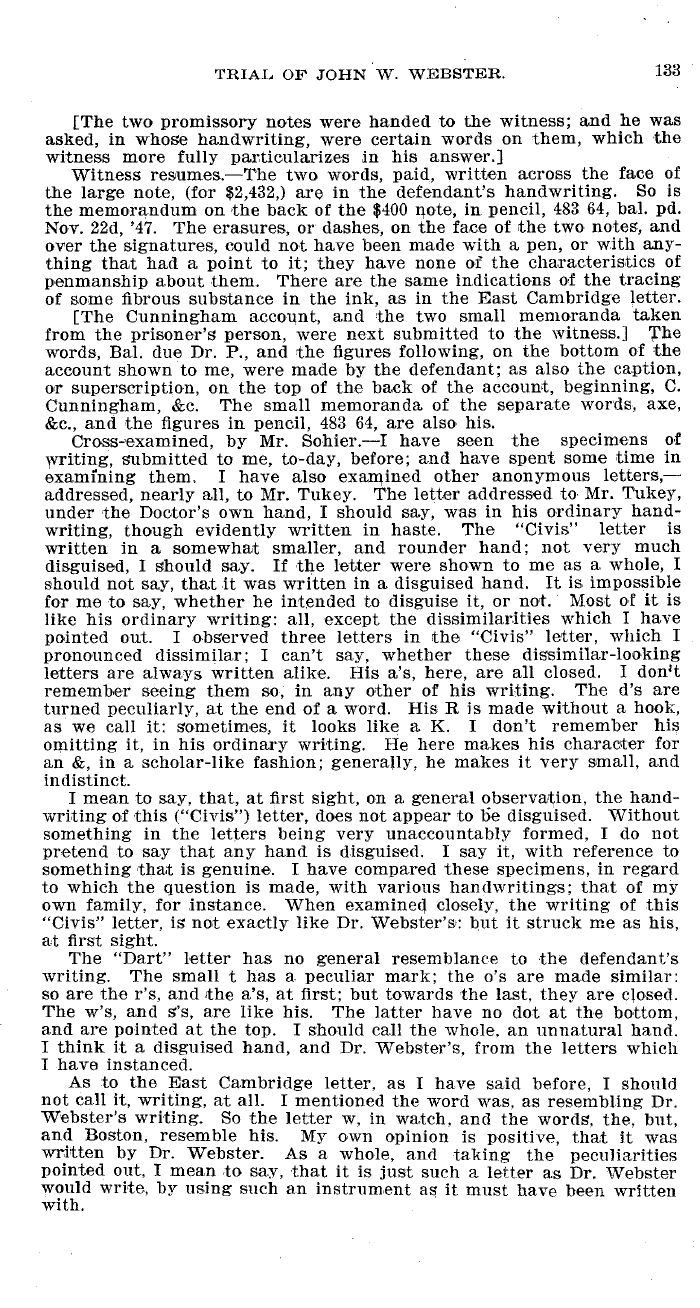|
TRIM. OF JOHN lv. WEBSTER. 133
[The two promissory notes were handed to the witness; and he was
asked, in whose handwriting, were certain words on them, which the
witness more fully particularizes in his answer.]
Witness resumes.-The two words, paid, written across the face of
the large note, (for $2,432,) are in the defendant's handwriting. So is
the memorandum on the back of the $400 note, in pencil, 483 64, bal. pd.
Nov. 22d, '47. The erasures, or dashes, on the face of the two notes, and
over the signatures, could not have been made with a pen, or with any-
thing that had a point to it; they have none of the characteristics of
penmanship about them. There are the same indications of the tracing
of some fibrous substance in the ink, as in the East Cambridge letter.
[The Cunningham account, and the two small memoranda taken
from the prisoner's person, were next submitted to the witness.] the
words, Dal. due Dr. P., and the figures following, on the bottom of the
account shown to me, were made by the defendant; as also the caption,
or superscription, on the top of the back of the account, beginning, C.
Cunningham, &c. The small memoranda of the separate words, axe,
&c., and the figures in pencil, 483 64, are also his.
Cross-examined, by Mr. Sohier.-I have seen the specimens of
writing, submitted to me, to-day, before; and have spent some time in
examining them, I have also examined other anonymous letters,-
addressed, nearly all, to Mr. Tukey. The letter addressed to Mr. Tukey,
under the Doctor's own hand, I should say, was in his ordinary hand-
writing, though evidently written in haste. The "Civis" letter is
written in a somewhat smaller, and rounder hand; not very much
disguised, I should say. If the letter were shown to me as a, whole, I
should not say, that it was written in a disguised hand. It is. impossible
for me to say, whether he intended to disguise it, or not. Most of it is
like his ordinary writing: all, except the dissimilarities which I have
painted out. I observed three letters in the "Civis" letter, which I
pronounced dissimilar; I can't say, whether these dissimilar-looking
letters are always written alike. His a's, here, are all closed. I don't
remember seeing them so, in any other of his writing. The d's are
turned peculiarly, at the end of a word. His R, is made without a hook,
as we call it: sometimes, it looks like a K. I don't remember his
omitting it, in his ordinary writing. He here makes his character for
an &, in a scholar-like fashion; generally, he makes it very small, and
indistinct.
I mean to say, that, at first sight, on a general observation, the hand-
writing of this ("Civis") letter, does not appear to lie disguised. Without
something in the letters being very unaccountably formed, I do not
pretend to say that any hand is disguised. I say it, with reference to
something that is genuine. I have compared these specimens, in regard
to which the question is made, with various handwritings; that of my
own family, for instance. When examines] closely, the writing of this
"Civis" letter, is not exactly like Dr. Webster's: but it struck me as his,
at first sight.
The "Dart" letter has no general resemblance to the defendant's
writing. The small t has a. peculiar mark; the o's are made similar:
so are the r's, and the a's, at first; but towards the last, they are dosed.
The w's, and g's, are like his. The latter have no dot at the bottom,
and are pointed at the top. I should call the whole, an unnatural hand.
I think it a disguised hand, and Dr. Webster's, from the letters which
I have instanced.
As to the East Cambridge letter, as I have said before, I should
not call it, writing, at all. I mentioned the word was, as resembling Dr.
Webster's writing. So the letter w, in watch, and the words, the, but,
and Boston, resemble his. My own opinion is positive, that it was
written by Dr. Webster. As a whole, and taking the peculiarities
pointed out, I mean .to sap, that it is just such a letter as Dr. Webster
would write, by using such an instrument as it must have been written
with.
|

